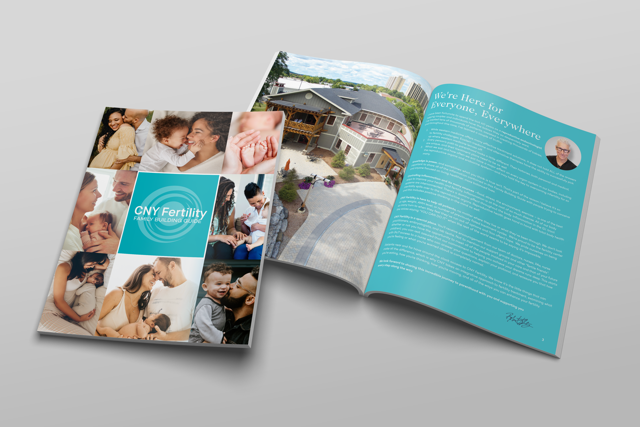What Is Ovarian Hyperstimulation Syndrome (OHSS)?

Ovarian Hyperstimulation Syndrome, often shortened to OHSS, is a possible complication that can occur during fertility treatment, especially during IVF or any cycle where injectable fertility medications are used to stimulate the ovaries.
OHSS happens when the ovaries respond too strongly to these medications, leading to enlarged ovaries and fluid shifts in the body.
While the possibility of OHSS can sound concerning, it’s important to know that modern medication protocols, careful monitoring, and individualized treatment planning have made significant OHSS cases far less common today. At CNY Fertility, OHSS prevention is an intentional part of treatment design from the very beginning.
OHSS vs. Controlled Ovarian Hyperstimulation (COH): What’s the Difference?
These two terms can be confusing, and they describe very different things.
Controlled ovarian hyperstimulation (COH) is the planned and safe process of stimulating the ovaries to produce multiple mature follicles during a fertility cycle. It’s an essential part of IVF, egg and embryo freezing, and sometimes IUI.
OHSS, on the other hand, is an unintended complication of ovarian stimulation when the response is stronger than desired.
In other words:
- COH is a fertility treatment technique.
- OHSS is a potential side effect, not the goal,
With today’s monitoring tools and tailored dosing, the vast majority of patients do not experience moderate or severe OHSS.
What Causes OHSS?
OHSS develops when hormone levels, particularly estradiol, rise rapidly and the ovaries produce an unusually high number of follicles. This can lead to fluid leaking out of blood vessels and accumulating in the abdomen.
People who are more likely to develop OHSS often include those who :
• Have polycystic ovary syndrome (PCOS)
• Have a high antral follicle count (AFC) or high anti-müllerian hormone AMH level
• Respond unusually strongly to gonadotropins
• Are younger than 35 or have a high ovarian reserve
Even if someone has one or more of these risk factors, OHSS can still be prevented or minimized with the right protocol and monitoring plan.
OHSS Symptoms
OHSS symptoms vary from mild to severe. Many people undergoing IVF experience mild bloating or abdominal fullness, which can be completely normal and not necessarily OHSS.
Common mild OHSS symptoms may include:
• Bloating
• Mild abdominal discomfort
• Feeling “full” or pressure in the pelvis
Moderate to severe OHSS symptoms may include:
• Rapid abdominal swelling
• Significant bloating
• Nausea or vomiting
• Shortness of breath
• Rapid weight gain
• Decreased urination
• Painful, enlarged ovaries
If symptoms worsen suddenly or interfere with breathing, urination, or movement, medical attention is needed. CNY patients experiencing symptoms can always reach out to their care team.
How Long Does OHSS Last?
Mild symptoms typically improve within 7–10 days after an egg retrieval. If pregnancy occurs in that same cycle, symptoms may take longer to resolve because early pregnancy hormones temporarily intensify the ovarian response.
How OHSS Is Prevented at CNY Fertility
The best approach to OHSS is prevention, and modern IVF protocols are designed with that in mind. At CNY Fertility, several strategies are used to significantly reduce risk:
Individualized Medication Dosing
Stimulation medications are not “one size fits all.” They are customized based on ovarian reserve testing, medical history, diagnosis, and how your body responds during the cycle.
If you are at risk of OHSS, your provider will use the lowest possible dose of gonadotropins to optimize the number of mature eggs retrieved safely.
Frequent Monitoring
Regular ultrasound and bloodwork monitor follicle growth and hormone levels. This allows your care team to adjust dosage in real time.
Trigger Shot Adjustments
Instead of using traditional hCG triggers in high-risk patients, alternatives such as Lupron (GnRH agonist) triggers significantly reduce the chance of OHSS.
Research shows that using an antagonist protocol of optimal dose gonadotropins and a Lupron trigger has been found to virtually eliminate the risk of OHSS.
Freeze-All Strategy
If risk remains high after stimulation, embryos may be frozen rather than transferred immediately. This prevents pregnancy hormones from worsening symptoms while protecting long-term success.
How to Reduce OHSS Symptoms at Home (When Mild)
If your provider confirms symptoms are mild and safe to manage at home, supportive strategies may help, such as:
• Staying hydrated (electrolyte balance matters more than plain water alone)
• Drinking beverages high in sodium, like electrolyte drinks or broth
• Eating small, protein-rich meals
• Wearing loose, comfortable clothing
• Avoiding high-impact exercise or deep twisting movements
Walking gently and avoiding strenuous abdominal movements can also help reduce discomfort.
How to Prevent OHSS After Egg Retrieval
After retrieval, continue following your care team’s instructions, which may include:
• Monitoring your weight and abdominal size
• Tracking symptoms
• Drinking electrolyte-balanced fluids
• Avoiding strenuous activity
• Reporting any sudden change in symptoms
Early awareness and communication can prevent symptoms from progressing.
When to Call Your Provider
Call CNY Fertility if you experience:
• Shortness of breath
• Severe abdominal pain
• Inability to urinate
• Rapid weight gain (more than 2 pounds in 24 hours)
• Persistent nausea or vomiting
• Sudden severe bloating
You are never bothering your care team; they would rather check early than late.
Can You Still Have a Successful IVF Cycle if You’re at Risk for OHSS?
Yes. With tailored medication doses, careful monitoring, and modern trigger protocols, most patients who are at higher risk go through IVF safely and successfully.
In many cases, a freeze-all approach further protects comfort and long-term success.
The Bottom Line on OHSS
OHSS is a recognized but increasingly preventable complication of ovarian stimulation. With today’s advancements, most patients will never experience moderate or severe OHSS, especially when working with a clinic experienced in close monitoring and personalized protocols.
At CNY Fertility, every stimulation plan is designed with safety in mind, so patients can focus on what matters most: growing their family with confidence and support. Schedule a consultation today to see how we can assist you in your fertility journey.


